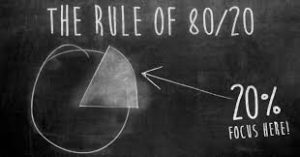Six Ways to ‘Pareto’ Everything You Do From Work to Your Personal Life
May 1, 2022

I first encountered the 80/20 rule while working on my first startup. We were taking a workshop when it was presented in the context of product engagement. Basically, for most digital products like web and mobile apps, around 80% of your product usage will likely come from around 10-20% of your user-base. Being a science nerd, I immediately went out test it and from then on, I became quite fascinated with this “principal” called the law of vital few. I’m fascinated by how this principal applies to many aspects in business, productivity and life in general. So, lets break it down and see how it works:
The Pareto Principal
The 80/20 or the Pareto principal basically means that in many events 80% of the effects come from 20% of the causes. The Pareto principle name came from the Italian economist Vilfredo Pareto who discovered the principle after realizing that approximately 80% of the land in Italy was owned by 20% of the population, and he kept observing the same pattern in other different situations. We can observe the Pareto principals in other area of daily living such as:
- You wear 20% of your clothes 80% of the time.
- 20% of your customers make 80% of the complaints.
- 20% of your customers are 80% of your revenue.
- 20% of the exercises you do give 80% of the results you receive.
The 80/20 rule is a simplified universal truth about the imbalance of inputs and outputs. You don’t need to create mathematical formulas or apply complex statistics. The 80% and 20% are just indicators. You should avoid the misconception that the numbers should always be 80 and 20. The point isn’t the ratio, it’s the imbalance…the inequality.
Applying the 80/20 rule
The interesting thing I find about the 80/20 rule is the ability to analyze your goals and tasks. It only makes sense to focus your energy and attention on these most critical tasks that brings you the most value at work and in your personal life. You can save a lot of time and make much faster progress by focusing on the most effective tasks. Generally speaking, here is how you can 80/20 most of your activities regardless if it’s for work or the tasks of everyday living:
1. Identify your goals. What are you trying to accomplish at work? You may have more than one goal, and that’s fine. However, it’s imperative to be aware of your goals. If you don’t have goals that were provided by your boss, create your own. What are your goals?
- Get a raise or a promotion?
- Ultimately find a job with a new company?
- Increase sales by 15%?
- Decrease complaints by 10%?
- Reduce payroll by 10%?
- Get your quarterly report completed on time?
2. Pick the most important goals. Not all goals are created equal. Think about which goals are most important to you, your boss, and your company. Maybe you can achieve all of your goals, but maybe you can’t. Which of your identified goals are most important?
3. Identify all of the tasks that will help to achieve those goals. Think of every single task that can be done to achieve your goals. Write down every idea you can think of. For example:
- What is every single thing you could do to reduce the payroll in your department?
- What is every single thing you could do to boost sales?
- Be open minded and creative. The best idea might be something you normally wouldn’t consider.
4. Prioritize those tasks. Every action has a different effect. Some actions accomplish a lot more than others. For example, making 500 cold calls each week will do more to boost your sales than giving yourself a morning pep talk.
- Look at the goal and look at the proposed action. Which action will have the greatest impact on achieving that goal?
- Put all the actions in order from most effective to least.
5. Put your energy and focus on those most important tasks. In theory, the top 20% of the actions you’ve identified are worth your time and effort. Most of the remaining 80% should be ignored. Remember that in your situation, it might not be 80-20. It might be 90-10. Or it might be 85-15. It’s simply a ratio of options to results. The point is that a few options matter much more than the others.
6. Outsource what you can. The more time and effort that can be applied toward those tasks in the top 20%, the more successful you’ll be. Look for help. In fact, sometimes the best help is outside the company. It might be worthwhile to hire additional help temporarily or permanently.
7. Repeat! Stay the course. The less important actions you can take are tempting because they’re often less uncomfortable to perform and still give the illusion of making progress. Focus on those critical tasks and you’ll see great progress.
Focusing your time and attention
You can put the 80/20 rule to work whether you’re an entrepreneur, a consultant or working at corporate. R
- Make a list of the things you spend the most time on.
- Select or prioritize only the ones that truly drive your results.
- Do more of those.
- Reduce or eliminate. Automate or outsource what you can and pause on the rest.
- Repeat
Pareto your everyday life
You can be pretty successful at many things if you identify the most important tasks and avoid wasting your time on anything else. Look for ways to apply the Pareto Principle to your life. Think about how you can apply the same 80/20 principle to other aspects of your life:
- Health and exercise
- Finances and wealth management
- Managing friends and family relationships
- Household chores
- Learning
- Hobbies
- Volunteering
Think about what part of your life do you most want to change for the better. Then apply the 80/20 to deciding the most important actions you can take in each area that will bring you the most value, growth and happiness.

